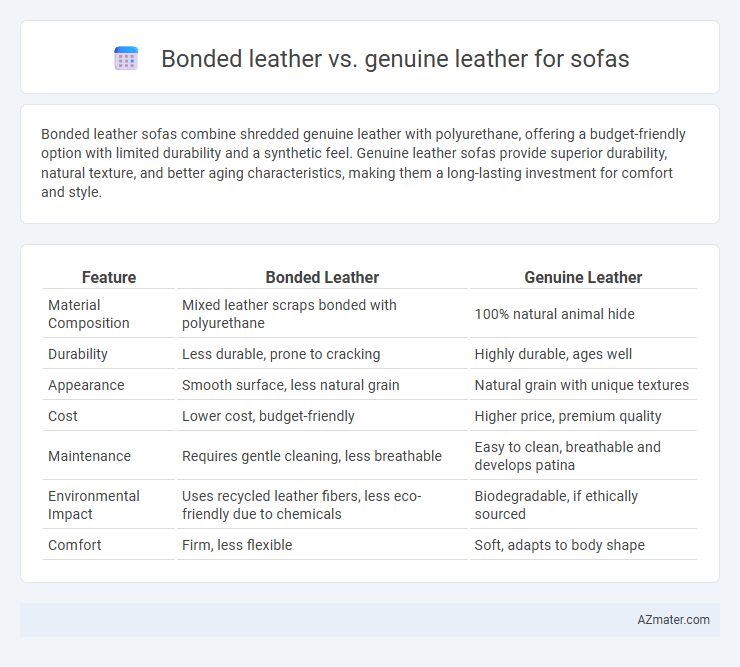Bonded leather sofas combine shredded genuine leather with polyurethane, offering a budget-friendly option with limited durability and a synthetic feel. Genuine leather sofas provide superior durability, natural texture, and better aging characteristics, making them a long-lasting investment for comfort and style.
Table of Comparison
| Feature | Bonded Leather | Genuine Leather |
|---|---|---|
| Material Composition | Mixed leather scraps bonded with polyurethane | 100% natural animal hide |
| Durability | Less durable, prone to cracking | Highly durable, ages well |
| Appearance | Smooth surface, less natural grain | Natural grain with unique textures |
| Cost | Lower cost, budget-friendly | Higher price, premium quality |
| Maintenance | Requires gentle cleaning, less breathable | Easy to clean, breathable and develops patina |
| Environmental Impact | Uses recycled leather fibers, less eco-friendly due to chemicals | Biodegradable, if ethically sourced |
| Comfort | Firm, less flexible | Soft, adapts to body shape |
Introduction to Bonded Leather and Genuine Leather
Bonded leather consists of leather fibers bonded together with polyurethane or latex on a fiber sheet, offering a cost-effective alternative with a similar appearance to genuine leather but lower durability. Genuine leather is made from the top layer of animal hides, providing natural strength, breathability, and a premium feel that improves with age. For sofas, genuine leather generally delivers superior longevity and comfort, while bonded leather suits budget-conscious consumers seeking leather aesthetics.
Composition and Manufacturing Process
Bonded leather consists of shredded genuine leather fibers mixed with polyurethane or latex and pressed onto a fiberboard, creating an engineered material with a leather-like appearance. Genuine leather is derived directly from animal hides, undergoing tanning and finishing processes to enhance durability, texture, and natural grain patterns. The manufacturing process of bonded leather involves blending and binding leather scraps, while genuine leather requires extensive treatment of whole hides to preserve authenticity and quality.
Appearance and Texture Differences
Bonded leather sofas often have a more uniform and consistent appearance with a smooth, synthetic texture due to the blending of leather scraps and polyurethane, while genuine leather sofas exhibit natural grain patterns, rich textures, and slight imperfections that add character. The texture of genuine leather is typically soft, supple, and ages gracefully, developing a patina over time, whereas bonded leather tends to feel stiffer and may wear down faster with peeling or cracking. Genuine leather sofas generally provide a more luxurious and authentic look compared to the more artificial feel and appearance of bonded leather.
Durability and Lifespan Comparison
Bonded leather sofas consist of leather scraps bonded with polyurethane, which makes them less durable and prone to cracking or peeling within 1 to 3 years. Genuine leather sofas, made from natural animal hides, offer superior durability and can last 10 to 15 years or more with proper care, maintaining their appearance and strength over time. The lifespan difference significantly impacts long-term value, making genuine leather the preferred choice for durability and lasting quality.
Comfort and Feel on Sofas
Bonded leather sofas offer a smoother, more uniform surface that feels softer initially but may lack the breathability and durability of genuine leather. Genuine leather sofas provide a natural texture that becomes more supple and comfortable over time, adapting to body warmth and offering superior moisture absorption. For lasting comfort and a luxurious feel, genuine leather remains the preferred choice in sofa upholstery.
Maintenance and Cleaning Requirements
Bonded leather sofas require gentle cleaning with a damp cloth and mild soap to avoid peeling, as the material is a composite of leather scraps bonded with polyurethane. Genuine leather sofas need regular conditioning using specialized leather care products to maintain suppleness and prevent cracking, with spills wiped up promptly to avoid stains. Proper maintenance extends the lifespan of genuine leather, while bonded leather often has a shorter durability and may show wear faster under frequent use.
Cost and Value for Money
Bonded leather sofas cost significantly less than genuine leather options, offering an affordable choice for budget-conscious buyers. While bonded leather provides a similar look, genuine leather delivers superior durability, aging gracefully over time, which enhances long-term value for money. Investing in a genuine leather sofa typically ensures better comfort, resilience, and overall satisfaction compared to bonded leather alternatives.
Environmental Impact and Sustainability
Bonded leather is made from shredded leather fibers mixed with polyurethane or latex, making it less resource-intensive but challenging to recycle due to synthetic binders. Genuine leather, derived from animal hides, has a higher environmental footprint due to livestock farming, including methane emissions and water consumption, but it tends to be more durable and biodegradable. Choosing bonded leather may reduce initial environmental strain, while genuine leather offers longevity that can offset its ecological costs over time.
Suitability for Households and Usage Scenarios
Bonded leather offers affordability and easy maintenance, making it suitable for low-traffic households or guest rooms where budget-friendly decor is preferred. Genuine leather provides superior durability and breathability, ideal for high-traffic living areas and families seeking long-lasting sofas with natural wear resistance. Homes with pets or children benefit from genuine leather's robust texture, while bonded leather suits decorative pieces in less-demanding environments.
Verdict: Which Leather is Best for Your Sofa?
Genuine leather offers superior durability, natural breathability, and a luxurious feel, making it the best choice for long-term investment in sofas. Bonded leather, composed of leather scraps bonded with polyurethane, provides an affordable aesthetic but lacks the resilience and aging qualities of genuine leather. For a sofa that balances comfort, longevity, and value, genuine leather is the optimal material.

Infographic: Bonded leather vs Genuine leather for Sofa
 azmater.com
azmater.com